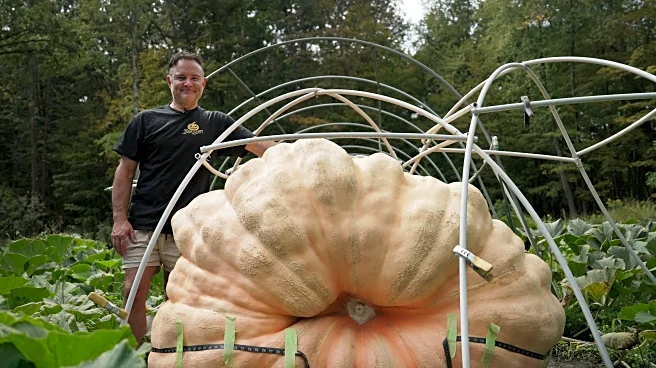What's Happening?
Tony Scott, a semiconductor engineer from upstate New York, has successfully grown a giant pumpkin weighing 1,931 pounds, earning third place in an annual weigh-off competition. Scott has been nurturing the pumpkin for months, using fertilizer and protective measures to ensure its growth. The pumpkin, which weighs almost as much as a small car, is part of a tradition where growers compete with colossal fruits, often exceeding 2,000 pounds. The process involves selecting the perfect seed, such as the Atlantic Giant pumpkin seeds, and providing the right combination of water, nutrients, and care. Growers remove smaller pumpkins to concentrate resources on a single fruit, resulting in massive growth. Scott's pumpkin is lighter in color due to protective measures against sunlight, and he uses an overhead sprinkler system for watering.
Why It's Important?
The cultivation of giant pumpkins is significant as it showcases the intersection of agriculture and science, highlighting the potential for innovation in crop production. This tradition not only serves as a competitive event but also contributes to local economies through fall festivals and Halloween fairs where these pumpkins are displayed. The practice of growing giant pumpkins can inspire advancements in agricultural techniques, potentially benefiting other crops and industries. It also emphasizes the importance of selecting optimal seeds and utilizing scientific methods to enhance growth, which could have broader applications in food production and sustainability.
What's Next?
Following the competition, Scott plans to display the giant pumpkin at various themed events, where it will be showcased and potentially carved. This tradition of showcasing giant pumpkins at festivals and fairs continues to attract public interest and engagement. Scott's efforts in protecting the pumpkin from wildlife and environmental factors highlight the challenges growers face, which could lead to further innovations in agricultural practices. The ongoing interest in giant pumpkin cultivation may encourage more individuals to participate in such competitions, fostering community involvement and promoting agricultural education.
Beyond the Headlines
The cultivation of giant pumpkins raises questions about the ethical and environmental implications of using extensive resources for non-food crops. While these pumpkins serve as a cultural and entertainment phenomenon, the practice prompts discussions on resource allocation and sustainability in agriculture. Additionally, the tradition of growing giant pumpkins reflects cultural values and community engagement, offering insights into how agricultural practices can influence social dynamics and local traditions.











